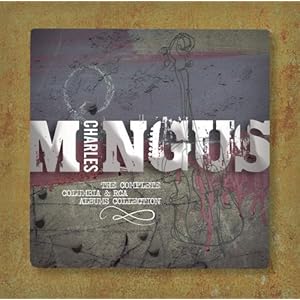Before hearing of Charles Mingus, the only jazz I had been exposed to was Benny Goodman, Duke Ellington and Count Basie. One Saturday morning, I go visit my friend Bob, who was slowly educating me on the finer points of this music. He sits me down, and putting on Mingus Ah Um, he declares, “I think you’re now ready for this,” while the opening strains of the wild gospel inflected “Better Git In Your Soul” starts rolling out of the speakers like a Pentecostal preacher. I was hooked. I wanted more More MORE!!!! This mult-disc set reissues not only some of the most important music that bassist/composer Charles Mingus ever recorded and released, but it also contains some of the essential sounds of the 20th century. Mixtures of traditional jazz, bebop, gospel, blues and Latin, all tempered with Mingus’ wildly unpredictable temper, make this music sui generis and essential listening. Mingus was on a ton of different labels during his career, and with each one he had a different style and band (but almost always with Dannie Richmond as drummer). These discs catch him at the beginning and end of his most fertile and influential periods.
If we review these discs in the chronological order of their recordings, and not when they were released, Tijuana Moods gets the earliest date, but with an asterisk. It was recorded in 1957, but not released until 1962. Even then, it was light years ahead of whatever was going on when it finally hit the streets. The sextet sessions include the famous on-off performance by Clarence Shaw, who blew the jazz world away with his famous trumpet solo which included his cleaning out his mouthpiece on “Dizzy Moods.” Meanwhile, the jazz world was never the same after the incessantly wild “Ysabel’s Table Dance,” complete with castinets and vocal yelpings, created more sparks than Ben Franklin’s jaunt with a kite.
In 1959, Mingus recorded his two most important and famous albums, Mingus Ah Um and Mingus Dynasty. To say which one is better is like saying which is your favorite Rita Hayworth movie. Ah Um includes some of his most famous pieces, such as “Goodbye Pork Pie Hat,” “Fables of Faubus” and the aforementioned “Better Git…” which all are now part of the jazz canon. The band of Richmond, Horace Parlan/p, Jerome Richardson/reeds, Jimmy Knepper/tb, John Handy/sax, Booker Ervin/sax, Shafi Hadi/sax may have been his best, and they all are at their zenith here. The multi-themed “Open Letter To Duke” is one of the most exciting yet ebullient pieces in jazz, while “Boogie Stop Shuffle” sounds like the theme to a film noir. A desert island disc.
Mingus Dynasty, along with a cd of out-takes, includes the 6/8 holy roller “Slop” as well as a collection of Ellingtonia in “Things Ain’t What They Used to Be” and “Mood Indigo” which features some thoughtful bass soloing by the leader. Some hard core bebopping takes place on “Gunslinging Bird,” contrasted with some pastoral sounds on “Far Wells, Mill Valley” and “Diane.” The only major personnel change is having Roland Hanna on piano and Benny Golson on tenor, which neither adds nor detracts from the session. The cd of alternate takes includes the ambitious 12 minute “Revelations” while the other two 59 sessions have some extra ditties like “Strollin’.” Wonderful moments galore.
You might get a bit suspicious of Mingus’ objectivity when both his Tijuana Moods AND his 1972 Let My Children Hear Music both say that they are “the best music I ever made.” Whether these claims are a case of Mingus’ ADD or simple artistic subjectivity, the music here, produced by Teo Macero (of Miles Davis fame) includes some of his most sophisticated writing. The rotating collage of musicians, which includes Knepper, Hanna, James Moody, Bucky Pizzarelli, Charles McPherson and Jaki Byard, give standard bearing readings of the wildly swinging “The Shoes Of The Fisherman’s Wife…”and the swirlingly creative “The I Of Hurricane Sue.” The riffing behind James Moody on “Hobo Ho” might cause you to increase your driving speed by 30-50 mph if you’re not careful and get caught up in the excitement. Guaranteed to make everything you’ve listened to the past 2 weeks sound stale and tired in comparison.
The 1972 released Mingus and Friends in Concert is his first material after what was essentially a 6 year hiatus. The list of musicians here is almost a Who’s Who collection, where else could Gene Ammons, Lee Konitz, Jon Faddis, Dizzy Gillespie, Howard Johnson, Milt Hinton, Randy Weston and Gerry Mulligan all share the (somewhat crowded) comfortably? Loose, wild, swinging and unpredictable, the musicians charge like a runaway train on material like “E’s Flat, Ah’s Flat Too” and “Little Royal Suite.” Oldies like “Jump Monk” and “Ecclusiastics” still sound ferocious and formidable after the sabbatical. Like watching a musical avalance!
The final 2 cds make up the posthumous Epitaph, which is musicologist/conductor Gunther Schuller’s attempt at bringing Mingus’ final (incomplete) compositional opus to fruition. Sort of like fully forming Beethoven’s 10th Symphony, as many have attempted, Schuller does a good try at trying to figure out how Mingus would have wanted it to sound, bringing in musicians like Randy Brecker, Bobby Watson and Wynton Marsalis along with alumni George Adams, Jerome Richardson and John Handy. Some of the songs from the 30 piece orchestra are familiar, as with “Peggy’s Blue Skylight” and “Better Git it in Your Soul” while the rest is long on inspiration and perspiration, but a bit short on realization. In one sense, it captures everything about the famed leader’s personality and temperament, which is something in itself.
If you’ve never heard this music before, you’ll hear jazz in a way that has set a standard that few since have reached. Hold on tight for this white knuckler, it’s the jazz version of California Screamin’!
